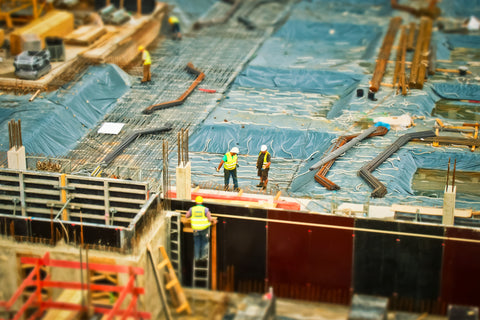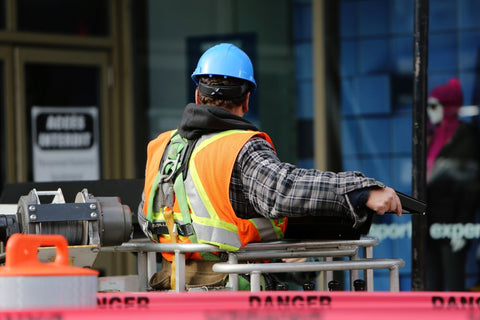Construction sites are a hub of activity. Often, heavy machinery, power tools, and more are all being operated at once creating a noisy environment. Within a construction site, it is challenging to communicate with fellow employees, contractors, and site managers.
Two-way radios are a great tool for ensuring that communications are consistent and clear. Without quick communication between those working on a construction site, there can be catastrophic consequences. Not only does a lack of communication mean physically dangerous conditions for contractors, but it also means delays on the job.
Below, learn five ways two-way radios, like XpressComm Two-Way Radio, can improve construction sites’ efficiency.
-
Reliable and Clear Communication
Construction sites can be anywhere, from city centers to the middle of the mountains; ironically, both of those areas can potentially have low cellular connection rates. Even in low cellular signal areas, two-way radios can operate to the highest capacity (“What is Two-Way Radio”). Therefore, they provide reliable communication even in challenging environments.
Another reward about using two-way radios while working on a construction site is the organization of communication. Many two-way radios can create communication groups by utilizing different channels or frequencies.
For instance, they can designate one channel as the place for group communication and other channels for separate teams. With this organization employees do not have to worry about having instructions that are privy to their team being interrupted by other teams.
-
Durable Technology
In addition to two-way radios being able to connect anywhere, they are also reliable because of the durability. Construction sites are filled with plenty of opportunities to break fragile technology, anywhere from high drops to working during peak temperatures.
Two-way radios are purposefully manufactured to withstand challenging environments like construction sites. Most portable two-way radios are built with IP-67 standards. This rating entails that the radio can continue working after and amidst shocks to the system (a short drop), high humidity days, below zero degrees, and even underwater submersion (“What does IP67 mean?”).
With the IP-67 standard rating, a two-way radio will last much longer as an everyday communication tool compared to an average cell phone on a construction site. In addition to the physical durability of two-way radios, they are also durable when it comes to the inside technology.
Although two-way radio technology is constantly being updated to perform better in specific situations, the core technology behind the two-way radio does not change. Therefore, your radio will be relevant for a long time.
-
Stay on Schedule and Reduce Errors
Two-way radios offer an ease of communication between coworkers, contractors, project managers, and anyone else on site. Radios allow for workers to be able to check in with the head contractors and vice versa to make sure all is in order and well throughout the shift (“Two Way Radios on Commercial…”).
Moreover, if any workers need further clarification, they can quickly ask the manager or head contractor without wasting time finding the person. Because two-way radios allow for quick communication between workers, the project has an easier time of staying on scheduling and a lower chance of errors occurring.

-
Long Battery Life
Other common communications technology like cell phones and computers do not come with long-lasting batteries. Most cell phones have an average of a six-hour battery if it is being used consistently. This timing is not compatible with a construction site job because many construction site shifts last eight or more hours at a time.
Two-way radio batteries are made to last eight or more hours at a time before needing any form of charge. Moreover, these batteries are constructed without a “memory.” Many cell phone and laptop batteries are configured to have a memory.
For instance, when some cell phones are charged at 50% battery, the battery life will start dropping quickly once it hits 50% because it will depend on that charge (“How To Maintain a Two-Way Radio Battery”). Two-way radio batteries do not have this memory construction so if a worker is on break and their radio is at 75% but they want it to be fully charged, they can do so without harming the future battery life.
A long battery life ensures employees do not have to worry about their form of communication dying and then risking their safety and work efficiency.
-
Safety Standards
Two-way radios offer quick communication between employees. They can let coworkers and managers know of any complications on the job. For instance, if there is a machine that is not working properly, that pertinent information can be relayed to the entire crew quickly over two-way radios.
Another example is if a pipe burst or there is a live wire, which is information that needs to be dispersed to the whole crew quickly for everyone’s safety. Overall, two-way radios can transmit necessary information between different team members to guarantee safety standards remain intact. For more information about the importance of communication and the role it plays in maintaining safety, visit OSHA’s page here.

…
Construction sites are filled with potential accidents; therefore, reliable communication between workers is of utmost importance. Two-way radios are a terrific way for construction sites to ensure the job gets done efficiently. Two-way radios offer reliable communication, durability, stay on schedule and reduce errors, long battery lives, and ensured safety standards; all these benefits can help any workplace’s efficiency.
Works Cited
“How To Maintain a Two-Way Radio Battery”. ERS Wireless, https://www.erswireless.com/blog/post-22.htm.
“OSHA Standards”. United States Department of Labor, https://www.osha.gov/hazcom/standards.
“Two Way Radios on Commercial Construction Jobsites”. Two Way Radio Center, https://www.twowayradiocenter.com/two-way-radios-in-construction.
“What does IP67 mean?”. L-Com, https://www.l-com.com/frequently-asked-questions%2Fi-need-to-get-waterproof-cable-connectors-or-adapters-what-does-ip67-mean.
“What is Two-Way Radio?”. Motorola Solutions, https://www.motorolasolutions.com/en_xu/solutions/what-is-two-way-radio.
The Best Hard Hats for 3M Hard Hat Attachment Headsets



1 comment
rmklabourhire
Great insights on improving construction site efficiency with two-way radios! Clear, practical, and spot-on advice. Thanks for sharing